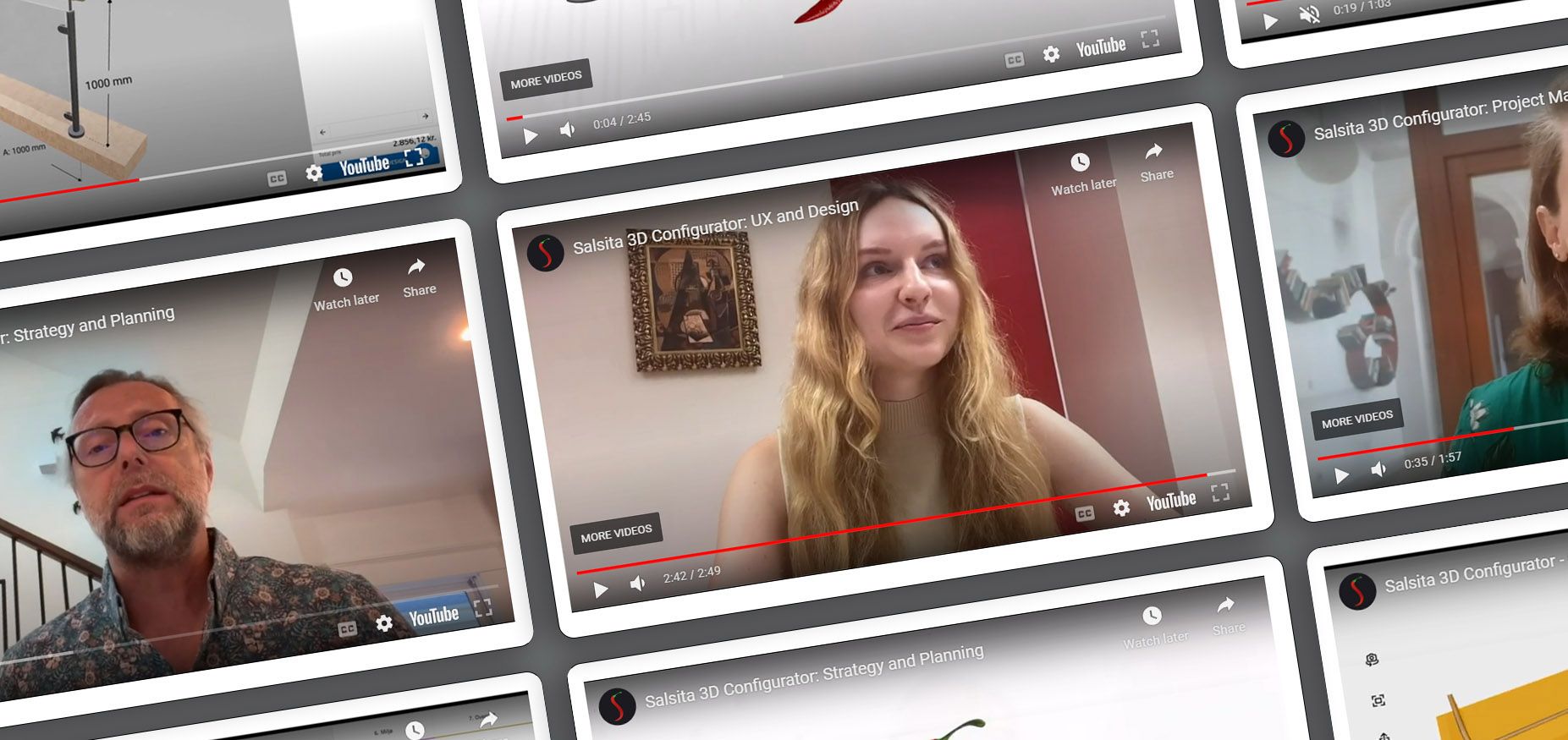
10 Questions to Ask Before Implementing a 3D Product Configurator
This article details the technical requirements and considerations when starting your 3D product configurator journey.
Table of Contents
3D product configurators come with a wide range of features. Without careful evaluation of your options, you may end up making the wrong selection. That’s why you need to consider which products will be configurable, how much detail to provide, and if you have the resources to implement a 3D product configurator.
According to Deloitte, 34% of customers interested in customization find standard products and services unsatisfactory. This makes selecting a configurator tailored for your needs extremely important. The features in a 3D product configurator vary based on your catalog size, configuration requirements, and need to scale.
For large product catalogs, you want to choose a solution with data-driven features and a robust rules engine for complex configurations. You may also want to include integration with your existing pricing, shopping cart, quote request and order features.
But how do you start? And what questions should you ask yourself and the vendor before implementing a 3D product configurator?
This article details the technical requirements and considerations when starting your 3D product configurator journey.
Considerations Before Implementing a 3D Product Configurator
Sure, a 3D configurator is worth investing in, but there are some factors to consider when implementing one:
- Clear goals: Before implementing a 3D product configurator, it’s necessary to know why you're doing it and what you hope to achieve.
- KPIs and benchmarks: If you can’t measure it, there’s no way to improve it—or know if the implementation was successful. Take care to select clear attainable metrics and benchmarks for success.
- Configurator features: Depending on your use case and requirements, you may need advanced features such as parametric models, drag and drop functionality, Augmented Reality (AR), or nested configurators.
- Team structure: Using a product configurator means having the right team to manage and operate the platform. For instance, you may need designers to help you build 3D models.
- Configurator delivery channels: Another factor to consider are the target platforms. In other words, how will customers experience the configurator—mobile, laptop and desktop, in-store screen, etc.
- Dynamic pricing options: If you’ll be offering dynamic pricing for products, then it’s vital to establish pricing rules for each product element or modification.
10 Questions to Ask Your Stakeholders Before Implementing a 3D Product Configurator
Choosing a 3D product configurator can be overwhelming; it is even more challenging to do it without knowing the right questions to ask. So, here are questions you can ask yourselves and a potential vendor.
What Underlying Technology Do You Use?
The underlying technology infrastructure of a product is critical to any implementation. Some 3D product configurators provide little flexibility and may be limited to a single platform. Examples of these include 3D configurator plugins on popular platforms like WooCommerce and Shopify.
Beyond this, you will want to ensure that you have the right skillset on board to manage the implementations after it goes live on your e-shop.
What Platforms (CMS, PIM, etc.) Does It Need to Integrate With?
While a product configurator is a standalone solution in its own right, integrating it with other existing applications can be a necessity. For instance, manufacturers may want direct customize-to-order features in a configurator, meaning you have to integrate with several tools such as:
- Enterprise Resource Planning (ERP)
- Client Relationship Management (CRM)
- Content Management System (CMS)
- Product Information Management (PIM)
- eCommerce store
- Personalization engine
In light of this, remember to indicate the systems you want the 3D product configurator to integrate with and ask the vendor which integration options are available.
SKUs or Not?
A Stock Keeping Unit (SKU) is simply a number for storing and keeping track of a brand’s inventory, but it allows retailers to differentiate between products. A standard SKU depicts a single item such as a white T-shirt, while a configurable SKU represents the customizable individual elements of a product, e.g.. hard disk in a computer, chairs in a dining set, or desktops when configuring a workspace. Be sure to ask the vendor if it supports configurable SKUs as part of its software.
How Many Options Are Available For Each SKU?
3D product configurators can encompass many elements in a product. If your product includes plenty of custom features and complexity, having multiple options for a SKU will be essential. In essence, you want to be able to cover all the variants of a given SKU , including its price, manufacturer, material, color, engravings, size, or type.
How Complex Are The Dependencies Between Options?
Every product has its own design options. Enterprises can implement some of these features in their configurator. However, it’s important to take note of the rules, dependencies, and associated complexities of your products. If you have product-specific constraints, the configurator should be able to handle them. For instance, you don’t want a room configurator that allows you to configure a couch that is larger than the length of the room. The more complex your products are, the greater the need for a custom 3D product configurator.
Do You Have 3D Models Or Will They Need to be Created?
You can’t have a 3D product configurator without 3D models. Enterprises that have in-house designers should have 3D models of their products ready for the configurator. But if you don’t, you’ll need to get them modeled. Be sure to ask your vendor which 3D model options are available.
Are Your Existing 3D Models High Quality?
Your 3D product configurator is only as visually appealing and impactful as the quality of your images. Customers feel let down when a brand's online presence isn’t up to par. Check the 3D models and images for quality, or ask if the vendor offers support for creating new, higher quality models.
Is Your Product Easy to Render in 3D?
Products encompass different levels of complexity. Modeling a 3D vehicle is quite different from modeling a table. Is it made up of simple shapes and straight lines? This complexity can affect the performance of the configurator. The greater the complexity, the longer it takes to download and render the model.
Which eCommerce Integrations Does The Configurator Offer?
One of the biggest advantages of product configurators is how they simplify the hand-off process to manufacturing. Automating business procedures for the sales-to-closing process is crucial. Depending on the configurator, it may only be handling the sales process and relying on integration with other platforms such as Shopify, Salesforce, or WooCommerce. The checkout process can also be custom-built. So you should find out which platforms the configurator integrates with.
Do You Need Additional Features?
Building a 3D product configurator can help streamline and accelerate the sales cycle. However, you may lose some benefits of the traditional sales process if some features aren’t available. For instance, as a global brand, you may want to enable multiple languages and currencies for your configurator.
Other important features may include AR capabilities and manufacturing documentation. Knowing the capabilities and features of the 3D product configurator can assist you in making an informed decision.
How Salsita Powers eCommerce Experiences With 3D Product Configurators
Adopting a 3D product configurator leads to better customer experience and engagement. This helps to drive more sales, fewer returns, and higher ROI. Choosing the right 3D product configurator is essential to achieving these benefits. With the questions listed in this article, you can get closer to making the right decision.
Salsita 3D Configurator is a solution you can rely on to deliver great value to your business. Rather than presenting users with a basic pre-packaged configurator, Salsita delivers a bespoke implementation tailored to your enterprise needs. Thanks to its MACH-compliant architecture, it offers seamless integration with existing enterprise products and eCommerce websites.

3D product configurators allow you to boost sales, increase engagement, reduce returns, and understand customer preferences for better personalization and innovation. And that’s what KILO accomplished after implementing Salsit 3D Configurator. More than that, it enabled higher scalability and automation through seamless integration with existing backend systems and manufacturing processes.










